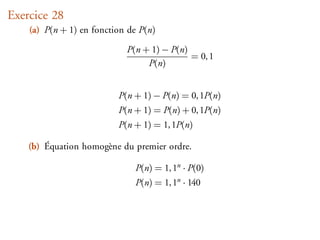Signaler
Partager
Télécharger pour lire hors ligne

Recommandé
Contenu connexe
Tendances
Tendances (19)
Introduction à la transformée en z et convolution discrète (GEII MA32)

Introduction à la transformée en z et convolution discrète (GEII MA32)
Exam of June 2016, Mathematical Statistics 3rd year

Exam of June 2016, Mathematical Statistics 3rd year
Similaire à Ch21 28
Similaire à Ch21 28 (6)
Plus de schibu20
Plus de schibu20 (20)
Ch21 28
- 1. Exercice 28 (a) P(n + 1) en fonction de P(n) P(n + 1) − P(n) = 0, 1 P(n) P(n + 1) − P(n) = 0, 1P(n) P(n + 1) = P(n) + 0, 1P(n) P(n + 1) = 1, 1P(n) (b) Équation homogène du premier ordre. P(n) = 1, 1n · P(0) P(n) = 1, 1n · 140
- 2. Exercice 28 (suite..) (c) On cherche n tel que P(n) ≥ 2P(1) P(1) = 140 × 1, 1 = 154 2P(1) = 308 Ainsi : 1, 1n · 140 ≥ 308 308 ln 140 n≥ 8, 273 ans. ln(1, 1) Soit après 9 ans.